
95% of researchers rate our articles as excellent or good
Learn more about the work of our research integrity team to safeguard the quality of each article we publish.
Find out more
BRIEF RESEARCH REPORT article
Front. Mar. Sci. , 24 July 2020
Sec. Marine Fisheries, Aquaculture and Living Resources
Volume 7 - 2020 | https://doi.org/10.3389/fmars.2020.00507
This article is part of the Research Topic The Status of Marine Fisheries in East Asia View all 16 articles
The Min River Estuary and its adjacent waters, connecting to the East China Sea, is one of the most important fishing grounds in Fujian Province, southern China; however, stock assessments have not yet been conducted. In the present study, the length-based Bayesian estimation method was applied for the first time to assess 20 single-species fishery stocks in the region. Catches of eight fish species from the Class Actinopterygii and 12 shrimp species from the Class Malacostraca were obtained from two commercial demersal trawlers, operated in the Min River Estuary and its adjacent waters, in February, May, August, and November of 2017 and 2018, covering all four seasons. The results showed that eight species were overexploited with an estimated B/BMSY (i.e., the current exploited biomass relative to the biomass producing the maximum sustainable yield) < 0.8 (range from 0.26 to 0.71). Three overexploited fish species (Gray’s grenadier anchovy Coilia grayii, the big head croaker Collichthys lucidus, and the Trevavas croaker Johnius trewavasae) are commercially important food species in the region. All four overexploited shrimp species (the shrimp Parapenaeopsis cultrirostris, the Japanese snapping shrimp Alpehus japonicus, and the Caridean shrimps Palaemon annandalei and Palaemon carinicouda) are small-sized and have low commercial value. The three-lined tongue sole Cynoglossus abbreviates, a commercially important species, was classified as fully exploited (0.8 ≤ B/BMSY ≤ 1.2). Osbeck’s grenadier anchovy Coilia mystus and the Japanese mantis shrimp Oratosquilla oratoria, both commercially important food species in the region, had non-fully exploited statuses (B/BMSY > 1.2). The results revealed that some commercially important food fishes are overexploited in the region and that small-sized, non-commercial food species can also be overexploited. There is an urgent need for local and national fisheries authorities to focus on coastal fishery management.
Stock assessments are essential for managing the fishery resources exploited. The age composition of fisheries catches provide, for many fisheries in, e.g., Europe and North America, the key parameters for stock assessments and evaluations (Fournier et al., 1998; Sparre and Venema, 1998; Mesnil, 2003; Benjamin and Kurup, 2012; Mäntyniemi et al., 2013; Francis et al., 2016; Zhu et al., 2016). However, age studies are time-consuming in fishes and are not feasible in crustaceans such as crabs and shrimps. Thus, length-frequency data, which can be collected easily from catches, have been widely used in stock assessments in both fishes (e.g., Munro, 1983; Fournier et al., 1990; Dennis, 1991; Pauly, 1998; Al-Qishawe et al., 2014; Nadon et al., 2015; Rudd and Thorson, 2018) and crustaceans (e.g., Pauly et al., 1984; Dineshbabu et al., 2007; Haist et al., 2009; Afzaal et al., 2016).
Notably, length-frequency data can be used to estimate L∞ and K, the parameters of the von Bertalanffy growth function (VBGF), which has the form:
where Lt is the mean size (here in diameter) at age t of the animals in question, Linf their asymptotic length, i.e., the mean length attained after an infinitely long time, and K a growth coefficient (here in year–1). Finally, t0, which cannot be estimated from length-frequency data alone, is the (usually negative) age they would have had at a size of zero if they had always grown in the manner predicted by the equation (which they have not; see, e.g., Pauly, 1998). However, the parameter t0, which allows the computation of mean length at absolute ages, is not required in most stock assessment models (Pauly, 1998). Other important parameters are mean length at the first capture (Lc, i.e., the length at which 50% of the fish are retained by the gear), the instantaneous rates of natural (M) and fishing (F) mortalities, which can be combined into a rate of total mortality (Z = M + F) and an exploitation rate (E = F/Z), as well as catch and effort time series for some methods.
Recently, a length-based Bayesian estimation (LBB) method was proposed to estimate stock status from length-frequency data, representative of commercial catches (Froese et al., 2018). To minimize the data requirements, the LBB method is not based on the absolute rates of growth and mortality but rather on the ratios of the rates of natural mortality to somatic growth (M/K) and of fishing mortality to somatic growth (F/K). Given representative length-frequency data, the LBB method, after estimating the above ratios, uses them to estimate the ratio of the current exploited biomass relative to unexploited biomass (B/B0) and relative to the biomass producing maximum sustainable yield (B/BMSY). The relative biomass estimated using the LBB method has been shown to have good validity for species that grow throughout their life span, such as most fish species (Froese et al., 2019)1.
China is the largest contributor to the global catch of marine fisheries (FAO, 2018). However, China’s marine fisheries resources have tended to be over-exploited since the 1970s, and dramatic declines in catches have occurred in some traditionally important commercial species and stocks (Jin et al., 2015; Kang et al., 2018a). As some of these declines or collapses may be attributed to the absence of strict management measures, fishery stock assessment is required.
Size measurement is the most fundamental and essential requirement in marine fishery resource surveys in China (Jin et al., 2012). This provides a great opportunity to assess commercial fishery stocks in Chinese waters using the LBB method when other parameters are little known. The Min River is the largest river in Fujian Province, and the estuary and its adjacent waters, connecting to the East China Sea, is one of the most important fishing grounds in Fujian Province (Fujian Province Atlas, 2001; Figure 1). Fisheries resources in the region have been shown to be declining; however, stock assessment has not yet been conducted, and the biology of most species has not yet been studied (Huang et al., 2010; Kang et al., 2018b). The objectives of the present study are to assess 20 fishery single-species stocks (henceforth, “species”) exploited by commercial demersal trawlers in the Min River Estuary and its adjacent waters using the LBB method. The samplings were conducted in all four seasons in 2017 and 2018, and a rapid understanding of the current status of the commercial fisheries was developed based thereon.
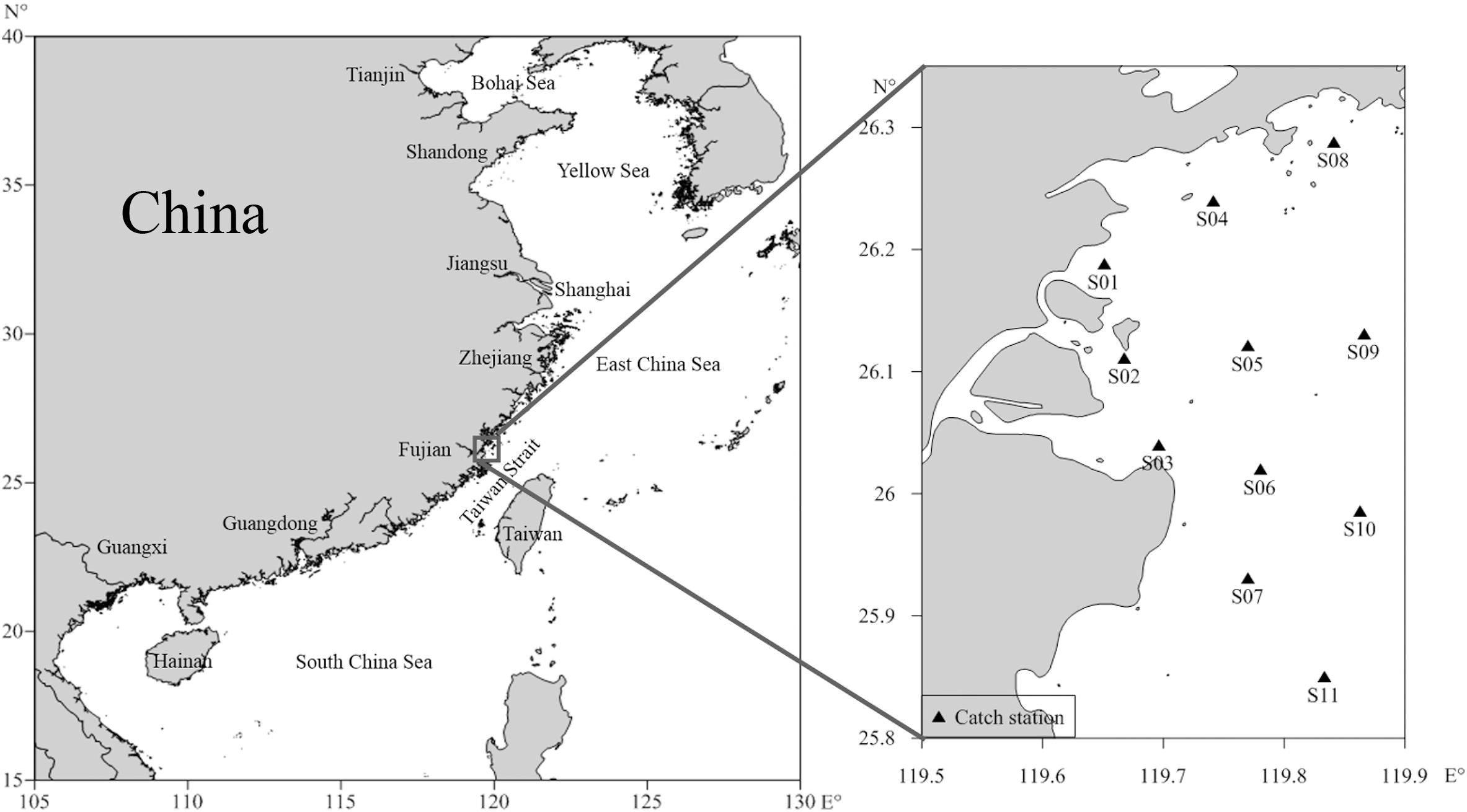
Figure 1. Location of the Min River Estuary and its adjacent waters (left: small square), Fujian Province, China, with the commercial trawl catches from 11 stations (right: S01–S11).
In the Min River Estuary and its adjacent waters (25.80°–26.30°N, 119.60°–119.90°E), two commercial demersal trawlers operated in 11 stations, covering all four seasons (February for Winter, May for Spring, August for Summer, and November for Autumn) in 2017 and 2018 (Figure 1). The power and size are 16.2 kW and 4 t for the small trawler, and 202 kW and 122 t for the large one. Both trawlers had mesh sizes of 4.5 cm at the net opening and 2.5 cm at the cod-end. The operating time of each station was around 30 min, and the speed was 3.7–7.8 km/h. The fishing areas have a depth range of 8–13 m and salinity range of 10–13 at Stations 01–03 (near the mouth of the river) and a depth range of 10–26 m and salinity range of 25–31 at Stations 04–11 (off the mouth of the river).
Catches of 20 species, including 8 fishes from the Class Actinopterygii and 1 mantis shrimp and 11 shrimps from the Class Malacostraca (henceforth all called “shrimps”), were collected. Standard length (SL, to 1 mm) and total length (TL, to 1 mm) were subsequently measured for fish species and carapace length (CL, to 1 mm) and standard length (SL, to 1 mm) for shrimp species. For each species, all individuals were measured if there were < 50 at a given station and season; 50 individuals were randomly selected if the sample size > 50 individuals. Eventually, the number of individuals measured ranged from 244 to 2508 for fish species, and from 129 to 1995 for shrimp species; all 20 species included small-sized juveniles and large adults, i.e., there was a wide size range (Table 1).
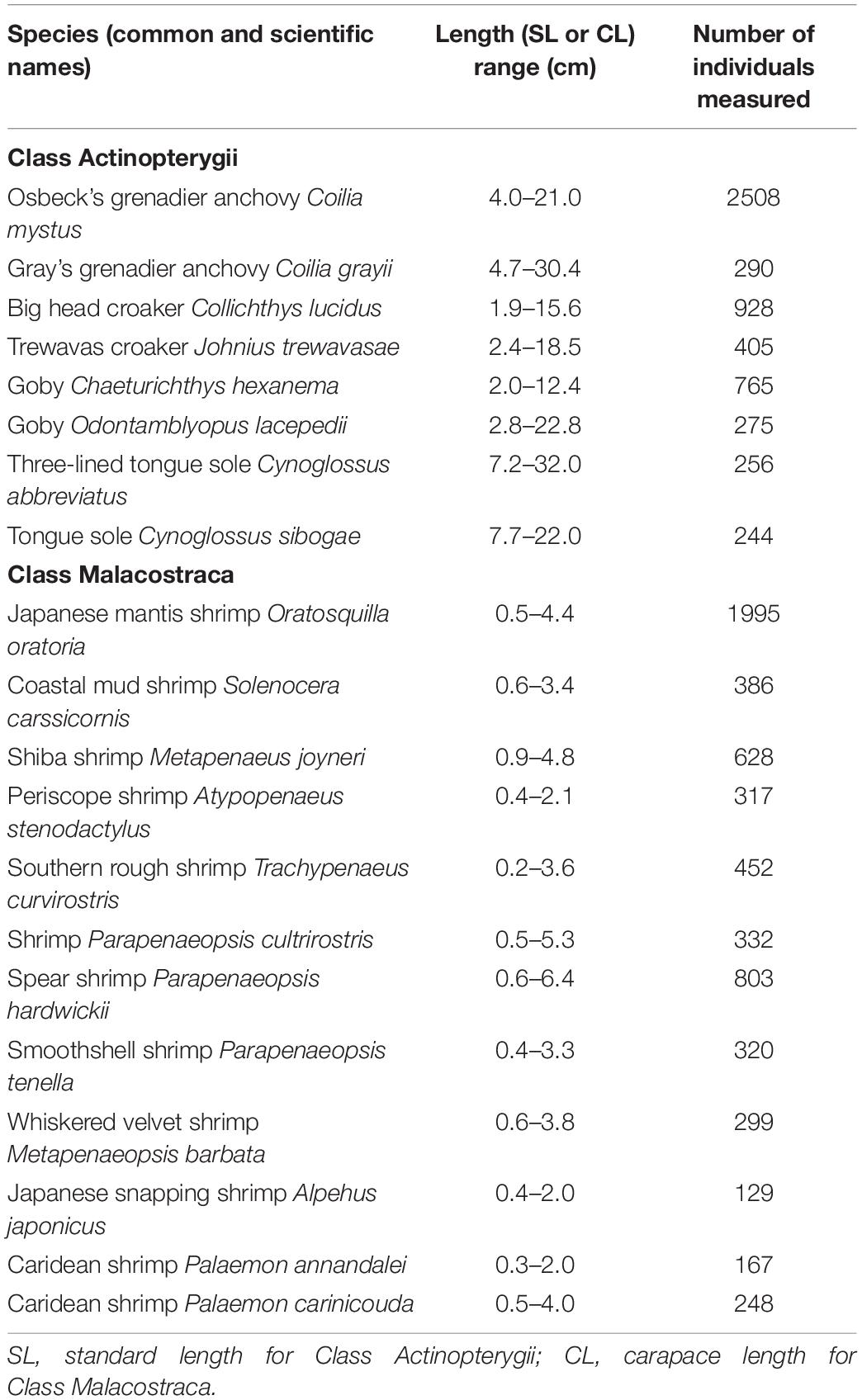
Table 1. Summary of the size range and the number of individuals measured of the 20 fish and shrimp species collected in 2017 and 2018 for stock assessment in the Min River Estuary and its adjacent waters, Fujian Province, southern China.
Length-frequency data (SL for fish species, CL for shrimp species) of each species accumulating from four seasons of two years were input into LBB version 28.0 in R version 3.5.0 software. The M/K prior was generated as 1.5 and the Linf as the maximum length obtained from the present study if the maximum length is unknown (for shrimp species) or the recorded maximum length (fish species from www.fishbase.org) is smaller than that of the present study. The Z/K prior was generated based on the equation (Beverton and Holt, 1957; Quinn and Deriso, 1999):
where is the average length of all individuals of the species measured above. The F/K prior is determined by (Z/K - M/K).
According to the obtained parameters (i.e., Lc, Linf, M/K, and F/K), the estimated B/B0 and B/BMSY values were generated (Froese et al., 2018). Stocks were classified to different categories based on the value of B/BMSY; non-fully exploited status was assigned where B/BMSY > 1.2, fully exploited status where 0.8 ≤ B/BMSY ≤ 1.2, and overexploited status where B/BMSY < 0.8 (Amorim et al., 2019).
Length-frequency data were adjusted slightly at 0.5, 1.0, and 1.5 cm SL intervals for fish species, and at 0.1, 0.2, 0.3, and 0.4 cm CL intervals for shrimp species. Through such debugging, the interval that made the analysis fit best (i.e., the length-frequency points fall on the trend curve as much as possible) was selected, and the corresponding length-frequency data were saved in EXCEL in “.csv” format. Information such as species name, sampling method, and Linf were saved in another “.csv” format file. More details and R-code2 are available (Froese et al., 2018).
The dominant length groups of all but one species (the big head croaker Collichthys lucidus) were smaller than the length (Lopt) that maximizes the biomass of an unexploited cohort (e.g., Figures 2, 3). The estimated Linf values were larger than or equal to the maximum size in the present study (Lmax) in 15 species, while they were smaller than the Lmax in only five species (Table 2).
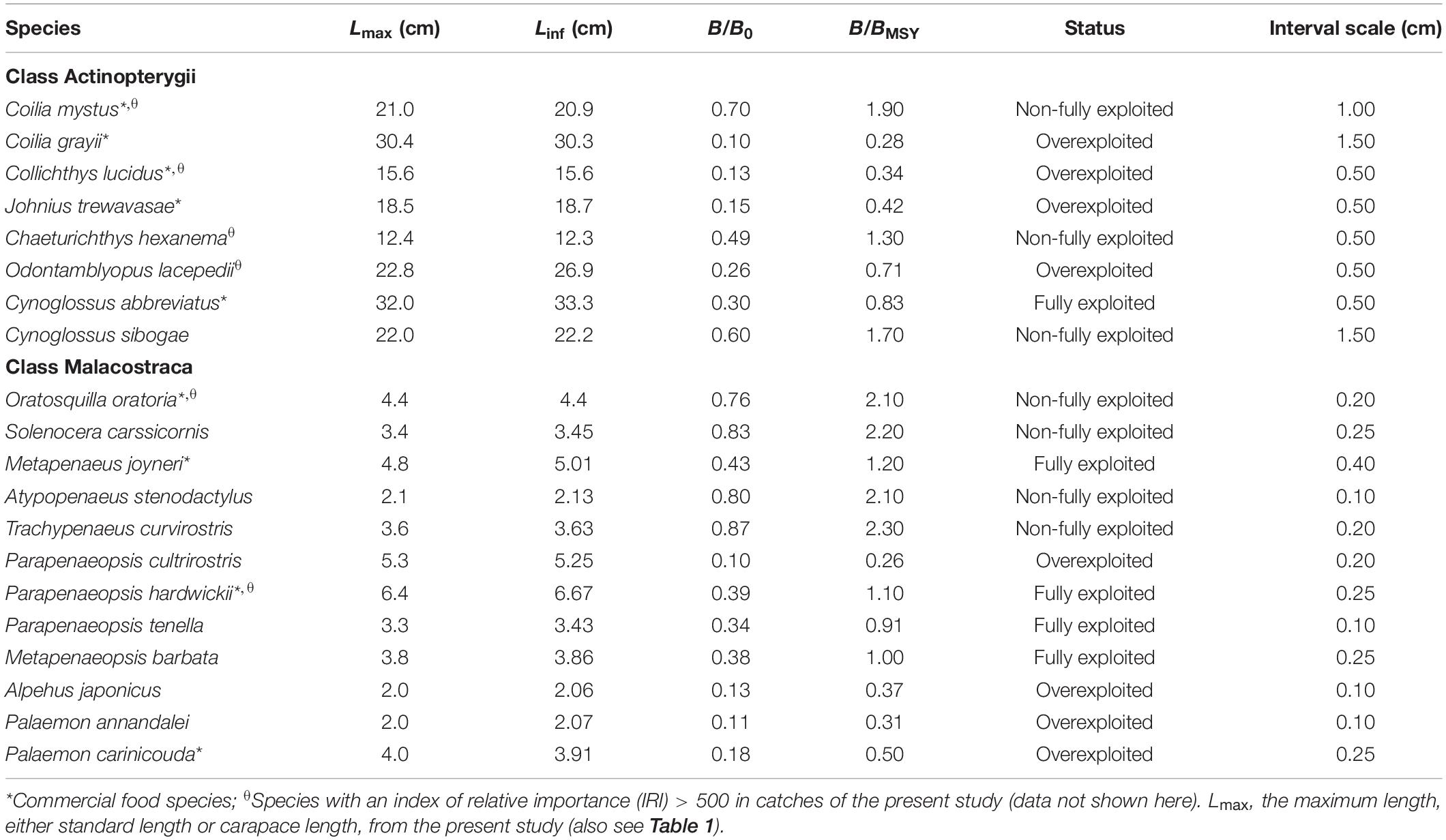
Table 2. Fishery statuses of the 20 species assessed in the Min River Estuary and its adjacent waters, Fujian Province, southern China.
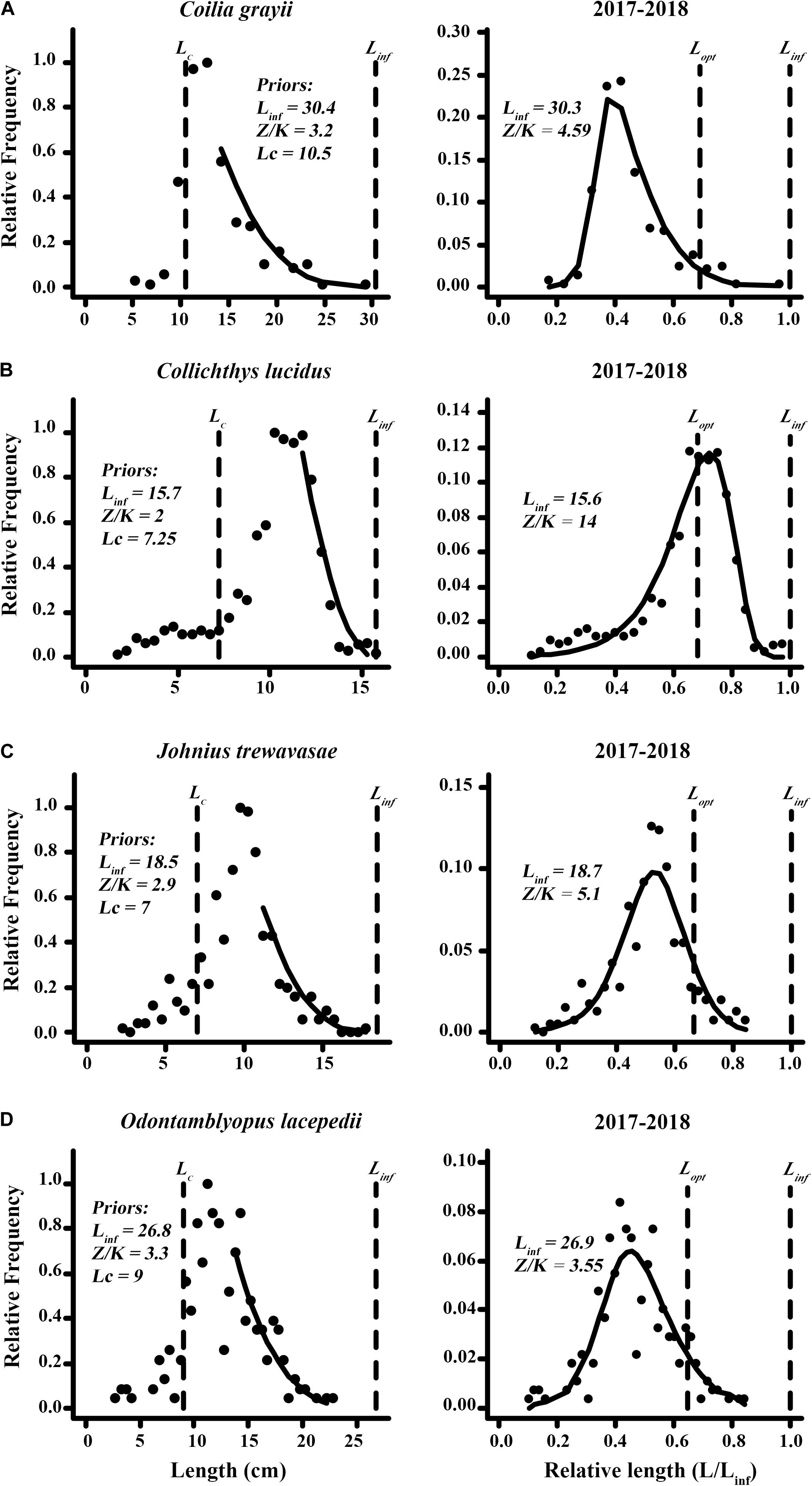
Figure 2. Results of assessment of four fish species with an overexploited stock status in the Min River Estuary and its adjacent waters, Fujian Province, southern China, with length data in 2017 and 2018. (A) Coilia grayii, (B) Collichthys lucidus, (C) Johnius trewavasae, and (D) Odontamblyopus lacepedii. The left panels estimate the length at 50% first capture (Lc), the asymptotic length (Linf), and the total mortality relative to somatic growth (Z/K) based on the catches of 2017 and 2018 as prior. The curves are fitted to fully selected length classes and provide the estimates of Linf and Z/K. The right panels show the length-frequency data from 2017 and 2018. The curves show the fitness of the LBB master equation and provide the estimates of Linf and Z/K. The Lopt is calculated from Linf and M/K, where the biomass of the unexploited stock is maximum.
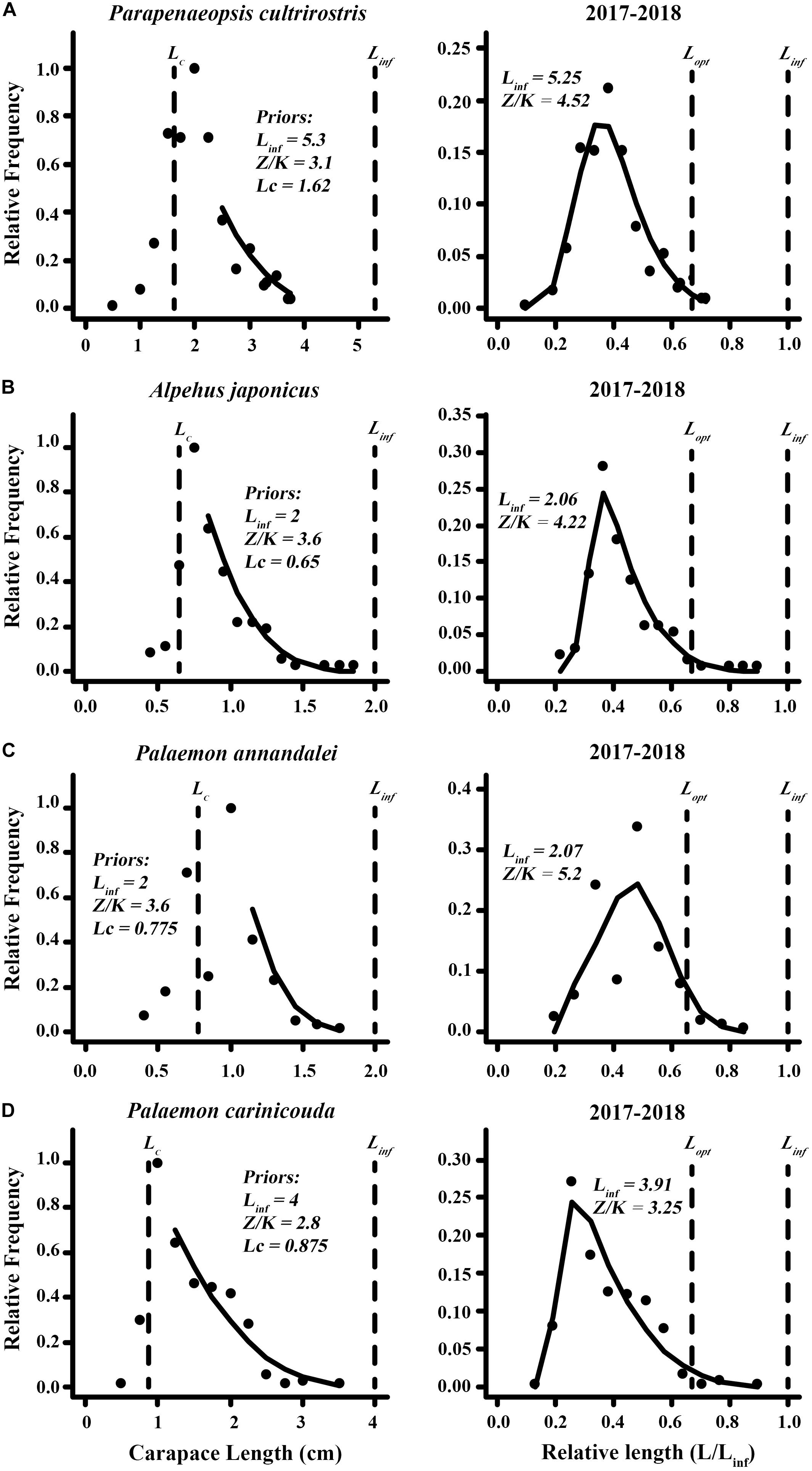
Figure 3. Assessment results of four shrimp species with an overexploited stock status in the Min River Estuary and its adjacent waters, Fujian Province, southern China, with length data in 2017 and 2018. (A) Parapenaeopsis cultrirostris, (B) Alpehus japonicus, (C) Palaemon annandalei, and (D) Palaemon carinicouda. The left panels estimate the length at 50% first capture (Lc), the asymptotic length (Linf), and the total mortality relative to somatic growth (Z/K) based on the catches of 2017 and 2018 as prior. The curves are fitted to fully selected length classes and provide the estimates of Linf and Z/K. The right panels show the length frequency data from 2017 and 2018. The curves show the fitness of the LBB master equation and provide the estimates of Linf and Z/K. Lopt is calculated from Linf and M/K, where the biomass of the unexploited stock is maximum.
The 20 species assessed belonged to one of the three statuses: overexploited, fully exploited, or non-fully exploited (Table 2). Eight species (40%), i.e., four fishes and four shrimps, had estimated B/B0 ratios ranging from 0.10 to 0.26 and B/BMSY ratios ranging from 0.26 to 0.71, suggesting overexploited status. Five species (25%), i.e., one fish and four shrimps, were fully exploited, with estimated B/B0 ratios ranging from 0.30 to 0.43 and B/BMSY ratios ranging from 0.83 to 1.20. Seven species (35%), i.e., three fishes and four shrimps, were non-fully exploited, with estimated B/B0 ratios ranging from 0.49 to 0.87 and B/BMSY ratios ranging from 1.30 to 2.30.
This study is the first time that the LBB method has been used to assess commercial fishery stock status in the Min River Estuary and its adjacent waters, southern China. The results provided valuable information for understanding the current degree of fishery exploitation in the region. Among the four fish species that were overexploited, Gray’s grenadier anchovy Coilia grayii in Engraulidae and the big head croaker C. lucidus in Sciaenidae require more attention (Table 2). C. grayii was listed as Least Concern in 2012 (Vidthayanon, 2012). It inhabits the waters near the mouths of the rivers and is a commercially important species in Fujian waters. C. grayii spawns in the mouth of the Min River every March–June and grows in the estuary year-round or offshore (Qiu, 1984). This is the first report on overexploitation of C. grayii stock in China. C. lucidus, an important food fish in China, inhabits estuaries and coastal waters down to a depth of 90 m over sandy and muddy bottoms (Chu and Wu, 1985; see footnote 1). It dominates in the Min River Estuary and its adjacent waters based on the index of relative importance (IRI; Zhang, 2020). A decline in the lengths in commercial catches of C. lucidus has been noted; SL ranged from 3.5 to 20.5 cm in 2006/2007, from 3.0 to 16.0 cm in 2015, and from 1.9 to 15.6 cm in 2017/2018 (Wang et al., 2011; Kang et al., 2018b; the present study). The smaller individuals in both C. lucidus and C. grayii samples indicate the existence of nursery grounds in the Min River Estuary and its adjacent waters. All four overexploited shrimp species are small-sized, benthic or demersal, and of low commercial value.
Among the fully exploited species, the three-lined tongue sole Cynoglossus abbreviates in Cynoglossidae and the spear shrimp Parapenaeopsis hardwickii in Penaeidae are of local commercial importance. The B/BMSY of C. abbreviates was 0.83, close to overexploited status. The abundance of P. hardwickii has increased over the past decade; the species was a general species in 2008 (IRI < 100) (Xu and Sun, 2013) and became a dominant species (IRI > 500) in 2017/2018 (Zhang, 2020).
Among the non-fully exploited species, Osbeck’s grenadier anchovy Coilia mystus in Engraulidae is an important food fish in China and inhabits estuaries and coastal waters (Ni et al., 1999). It was listed as Endangered in 2018 (Hata, 2018). The stock of C. mystus in the Yangtze River Estuary, the most abundant region in China, almost collapsed (Liu et al., 2013). In the Min River Estuary and its adjacent waters, less than 600 km distance from the Yangtze River Estuary, C. mystus is a dominant species (IRI > 500) (Zhang, 2020); however, the sizes of C. mystus in commercial catches has shown a decline over the years from 5.0–26.4 cm SL in 2006/2007 to 7.0–21.0 cm SL in 2015 and to 4.0–21.0 cm SL in 2017/2018 (Wang et al., 2011; Kang et al., 2018b; the present study).
The current stock statuses of the 20 species revealed that some commercially important food fishes are overexploited in the Min River Estuary and its adjacent waters and that small-sized, non-commercial food species can also be overexploited. This is likely due to the non-selective fishery method using small mesh-sized nets employed in commercial demersal bottom fisheries along the coastal waters of China. About 200 species of fishes, crustaceans, and cephalopods have been reported from the Min River Estuary and its adjacent waters (Kang et al., 2018b; Zhang, 2020). It will be a challenge to find a way to continue exploiting the Min River Estuary for its fisheries resources without impacting the biodiversity that makes the estuary so productive. There is an urgent need for local and national fisheries authorities to focus on coastal fishery management.
The datasets analyzed in this article are not publicly available. Requests to access the datasets should be directed to LZ.
The animal study was reviewed and approved by Fuzhou Ocean and Fisheries Bureau of China.
LZ and QR wrote the first draft. ML, QX, BK, and XJ revised the manuscript. LZ, QR, XJ, and ML performed the data analyses. All authors conducted commercial catch sampling and measurement.
This work was supported by the National Natural Science Foundation of China (grant no. 41976091) and the Fuzhou Ocean and Fisheries Bureau of China (contract no. XDHT2017074A). The funders had no role in study design, data collection and analysis, decision to publish, or preparation of the manuscript.
The authors declare that the research was conducted in the absence of any commercial or financial relationships that could be construed as a potential conflict of interest.
Frontiers Media SA remains neutral with regard to jurisdictional claims in published maps and institutional affiliations.
We thank Rui Guo, Zhi-jian Huang, Bai-an Lin, and Jian-jie Lin for sample collection and measurement.
The Supplementary Material for this article can be found online at: https://www.frontiersin.org/articles/10.3389/fmars.2020.00507/full#supplementary-material
Afzaal, Z., Kalhoro, M. A., Buzdar, M. A., Nadeem, A., Saeed, F., Haroon, A., et al. (2016). Stock assessment of blue swimming crab Portunus pelagicus (Linnaeus, 1758) from Pakistani waters (Northern, Arabian Sea). Pak. J. Zool. 48, 1531–1541.
Al-Qishawe, M. M. S., Ali, T. S., and Abahussain, A. A. (2014). Stock assessment of white spotted rabbitfish (Siganus canaliculatus Park, 1797) in Jubail marine wildlife sanctuary, Saudi Arabia. Int. J. Fish. Aquat. Stud. 1, 48–54.
Amorim, P., Sousa, P., Jardim, E., and Menezes, G. M. (2019). Sustainability status of data-limited fisheries: global challenges for snapper and grouper. Front. Mar. Sci. 6:654. doi: 10.3389/fmars.2019.00654
Benjamin, D., and Kurup, B. M. (2012). Stock assessment of dolphinfish, Coryphaena hippurus (Linnaeus, 1758) off the southwest coast of India. J Mar. Biol. Assoc. India 54, 95–99. doi: 10.6024/jmbai.2012.54.1.01675-1671
Beverton, R. J. H., and Holt, S. J. (1957). On the Dynamics of Exploited Fish Populations. London: Ministry of Agriculture, Fisheries and Food. Fishery Investigations.
Chu, Y., and Wu, H. (1985). “Sciaenidae,” in Fishes of Fujian Province Editorial Subcommittee, The Fishes of Fujian Province (Part II), Ed. X. L. Chu, (China: Fujian Science and Technology Press), 135–136.
Dennis, G. D. (1991). The validity of length-frequency derived growth parameters from commercial catch data and their application to stock assessment of the yellowtail snapper (Ocyurus chrysurus). Proc. Gulf Caribbean Fish. Inst. 40, 126–138.
Dineshbabu, A. P., Sreedhara, B., and Muniyappa, Y. (2007). Fishery and stock assessment of Portunus sanguinolentus (Herbst) from south Karnataka coast. India. J. Mar. Biol. Assoc. India 49, 134–140.
FAO, (2018). The State of World Fisheries and Aquaculture-Meeting the Sustainable Development Goals. Food and Agriculture Organization of the United Nations. Rome: FAO.
Fournier, D. A., Hampton, J., and Sibert, J. R. (1998). MULTIFAN-CL: a length-based, age-structured model for fisheries stock assessment, with application to South Pacific albacore. Thunnus alalunga. Can. J. Fish. Aquat. Sci. 55, 2105–2116. doi: 10.1139/cjfas-55-9-2105
Fournier, D. A., Sibert, J. R., Majkowski, J., and Hampton, J. (1990). MULTIFAN a likelihood-based method for estimating growth parameters and age composition from multiple length frequency data sets illustrated using data for southern bluefin tuna (Thunnus maccoyii). Can. J. Fish. Aquatic Sci. 47, 301–317. doi: 10.1139/f90-032
Francis, R. C., Aires-da-Silva, A. M., Maunder, M. N., Schaefer, K. M., and Fuller, D. W. (2016). Estimating fish growth for stock assessments using both age–length and tagging-increment data. Fish. Res. 180, 113–118. doi: 10.1016/j.fishres.2015.06.011
Froese, R., Winker, H., Coro, G., Demirel, N., Tsikliras, A. C., Dimarchopoulou, D., et al. (2018). A new approach for estimating stock status from length frequency data. ICES J. Mar. Sci. 75, 2004–2015. doi: 10.1093/icesjms/fsy078
Froese, R., Winker, H., Coro, G., Demirel, N., Tsikliras, A. C., Dimarchopoulou, D., et al. (2019). On the pile-up effect and priors for Linf and M/K: response to a comment by Hordyk et al. on “A new approach for estimating stock status from length frequency data”. ICES J. Mar. Sci. 76, 461–465. doi: 10.1093/icesjms/fsy199
Haist, V., Breen, P. A., and Starr, P. J. (2009). A multi-stock, length-based assessment model for New Zealand rock lobster (Jasus edwardsii). N. Zeal. J. Mar. Freshw. Res. 43, 355–371. doi: 10.1080/00288330909510006
Hata, H. (2018). Coilia mystus. The IUCN Red List of Threatened Species 2018: e.T98894402A143840543. doi: 10.2305/IUCN.UK.2018-2.RLTS.T98894402A143840543.en
Huang, L., Li, J., Zhang, Y., Xie, Y., Liu, Q., and Jin, X. (2010). Current fishery resource assessment in the Minjiang River Estuary and its neighboring waters. J. Trop. Oceanogr. 29, 142–148.
Jin, X., Dou, S., Shan, X., Wang, Z., Wan, R., and Bian, X. (2015). Hot spots of frontiers in the research of sustainable yield of Chinese inshore fishery. Progr. Fish. Sci. 36, 124–131. doi: 10.11758/yykxjz.20150119
Jin, X., Li, X., Zhao, X., Cheng, J., Li, S., and Zhang, H. (2012). Technical Specification for Marine Fishery Resource Survey. Beijing: Ministry of Agriculture of the People’s Republic of China.
Kang, B., Liu, M., Huang, X.-X., Li, J., Yan, Y.-R., Han, C.-C., et al. (2018a). Fisheries in Chinese seas: What can we learn from controversial official fisheries statistics? Rev. Fish Biol. Fish. 28, 503–519. doi: 10.207/s11160-018-9518-1
Kang, B., Li, J., Zhao, C., He, X., Wang, J., and Zhang, Y. (2018b). Ecological Environment and Fishery Resources in the Min River Estuary. Beijing: China Agriculture Press, 189.
Liu, K., Xu, D., Duan, J., Zhang, M., Fang, D., Zhou, Y., et al. (2013). Fluctuation of biological characteristics and yield of Coilia mystus in fishing season after impoundment of the three gorges dam in Yangze River Estuary. Resour. Environ. Yangze Basin 22, 1282–1288.
Mäntyniemi, S., Uusitalo, L., Peltonen, H., Haapasaari, P., and Kuikka, S. (2013). Integrated, age-structured, length-based stock assessment model with uncertain process variances, structural uncertainty, and environmental covariates: case of Central Baltic herring. Can. J. Fish. Aquat. Sci. 70, 1317–1326. doi: 10.1139/cjfas-2012-0315
Mesnil, B. (2003). The catch-survey analysis (CSA) method of fish stock assessment: an evaluation using simulated data. Fish. Res. 63, 193–212. doi: 10.1016/S0165-7836-03-00072-9
Munro, J. L. (1983). A cost-effective data acquisition system for assessment and management of tropical multispecies, multi-gear fisheries. Fishbyte 1, 7–12.
Nadon, M. O., Ault, J. S., Williams, I. D., Smith, S. G., and DiNardo, G. T. (2015). Length-based assessment of coral reef fish populations in the main and northwestern Hawaiian Islands. PLoS One 10:e0133960. doi: 10.1371/journal.pone.0133960
Ni, Y., Wang, Y., Jiang, M., and Chen, Y. (1999). Biological characteristics of Coilia mystus in the Changjiang estuary. J. Fish. Sci. China 6, 69–71.
Pauly, D. (1998). Beyond our original horizons: the tropicalization of Beverton and Holt. Rev. Fish Biol. Fish. 8, 307–334.
Pauly, D., Ingles, J., and Neal, R. (1984). “Application to shrimp stocks of objective methods for the estimation of growth, mortality and recruitment-related parameters from length-frequency data (ELEFAN I and II),” in Penaeid Shrimp, Their Biology and Management, eds J. Gulland, and B. Rothschild, (Great Britain: New Books), 220–234.
Qiu, S. (1984). “Engraulidae,” in Fishes of Fujian Province Editorial Subcommittee, The fishes of Fujian Province (Part I), Ed. X. L. Chu, (China: Fujian Science and Technology Press), 140–157.
Quinn, T. J., and Deriso, R. B. (1999). Quantitative Fish Dynamics. New York, NY: Oxford University Press.
Rudd, M. B., and Thorson, J. T. (2018). Accounting for variable recruitment and fishing mortality in length-based stock assessments for data-limited fisheries. Can. J. Fish. Aquat. Sci. 75, 1019–1035. doi: 10.1139/cjfas-2017-0143
Sparre, P., and Venema, S. C. (1998). Introduction to Tropical Fish Stock Assessment. Part 1: Manual. FAO Fisheries Technical Paper No. 306.1, Rev. 2. Rome: FAO.
Vidthayanon, C. (2012). Coilia grayii. The IUCN Red List of Threatened Species 2012: e.T166216A1120822. doi: 10.2305/IUCN.UK.2012-1.RLTS.T166216A1120822.en
Wang, J., Zhang, Y., Huang, L., Li, J., and Xie, Y. (2011). Fishery biology of main economic fishes in Fujian coastal waters. J. Jimei Univ. 16, 161–166. doi: 10.19715/j.jmuzr.2011.03.001
Xu, Z., and Sun, Y. (2013). Comparison of shrimp density between the Minjiang estuary and Xinhua bay during spring and summer. Acta Ecol. Sin. 33, 7157–7165. doi: 10.5846/stxb201207261060
Zhang, L. (2020). Fishery Nekton Resource and Community Diversity in Min River Estuary and its Adjacent Waters, Fujian Province, China. MSc Dissertation, Xiamen University, Xiamen, China.
Keywords: commercial trawl fishery, estuarine waters, fishes, shrimps, length-based Bayesian estimation
Citation: Zhang L, Ren Q, Liu M, Xu Q, Kang B and Jiang X (2020) Fishery Stock Assessments in the Min River Estuary and Its Adjacent Waters in Southern China Using the Length-Based Bayesian Estimation (LBB) Method. Front. Mar. Sci. 7:507. doi: 10.3389/fmars.2020.00507
Received: 31 December 2019; Accepted: 03 June 2020;
Published: 24 July 2020.
Edited by:
Maria Lourdes D. Palomares, The University of British Columbia, CanadaReviewed by:
Hui Zhang, Institute of Oceanology (CAS), ChinaCopyright © 2020 Zhang, Ren, Liu, Xu, Kang and Jiang. This is an open-access article distributed under the terms of the Creative Commons Attribution License (CC BY). The use, distribution or reproduction in other forums is permitted, provided the original author(s) and the copyright owner(s) are credited and that the original publication in this journal is cited, in accordance with accepted academic practice. No use, distribution or reproduction is permitted which does not comply with these terms.
*Correspondence: Min Liu, bWlubGl1eG1AeG11LmVkdS5jbg==
†These authors have contributed equally to this work
Disclaimer: All claims expressed in this article are solely those of the authors and do not necessarily represent those of their affiliated organizations, or those of the publisher, the editors and the reviewers. Any product that may be evaluated in this article or claim that may be made by its manufacturer is not guaranteed or endorsed by the publisher.
Research integrity at Frontiers

Learn more about the work of our research integrity team to safeguard the quality of each article we publish.